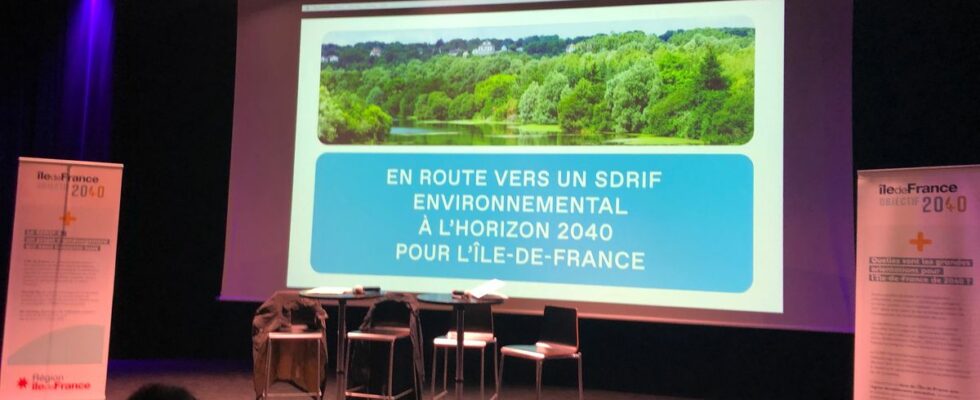“Does the City of Paris intend to build a new Bois de Boulogne? », « Why not consider free transport? », « Why not put more solar panels on the roofs? In the hall of the Pajol hall, in the 18th arrondissement of Paris, questions and proposals abound. Few people that evening (13 people), but a motivated group, invited by the Ile-de-France region to reflect on the next “Sdrif”.
This somewhat barbaric acronym, which means “master plan for the Île-de-France region”, designates the region’s roadmap for everything related to regional planning. As Philippe Schmidt, president of the regional environmental authority’s mission, summarized it to us beforehand by telephone, it is a “strategic document which sets out the guidelines for the region for the next 15-20 years” .
Mandatory consultation
The Sdrif “concerns all Ile-de-France residents. It answers a simple question: which Île-de-France in 2040? And in a very concrete way on everyday issues: how many homes do we want to build? How do we want to reconcile reindustrialisation, job creation and environmental protection? », explain the regionwho chose to name “her” Sdrif “Sdrif-E”, the E meaning “environment”, to mark the importance that she intends to give to this subject in her new document.
This document is so important that the region has the obligation to first engage in consultation with the inhabitants of the region, who can give their opinion. Meetings were therefore organized in each department, under the aegis of the National Commission for Public Debate, the last one having taken place on December 14 in Paris, at which 20 minutes has assisted.
Half an hour of group work
In the hall, participants are entitled to a short presentation video. “The Sdrif-E must limit urban sprawl, contribute to carbon neutrality, limit the production of waste”, we detail, before giving us the timetable: the first draft of the Sdrif will be adopted by the elected officials at the first quarter of 2023, then definitively adopted in 2024. The screen gives the floor to the president of the region, Valérie Pécresse, who invites everyone to contribute: “These questions concern you all. Then the Sdrif-E delegate, Valérie Belrose, announces the major issues, which the public is invited to prioritize on a sheet, after meeting in small groups.
Should we first fight against CO2 emissions? Adapt the territory to climate change? Have more accommodation? Develop the circular economy, mobility or even the attractiveness of the territory? Or reduce the artificialization of soils? In the group in which 20 minutes, we scratch our heads and we phosphorus. “We want to reduce the artificialization of soils but to enhance attractiveness, it’s contradictory! “, points out Barthélemy. “My point of view is that we shouldn’t build more housing, but give more to those who don’t have any,” Anne rebounds later. The debate begins, opinions diverge, converge, but in less than half an hour, do we really have time to settle such questions?
Factual elements
On the platform, Jean-Philippe Dugoin-Clément, vice-president of the Ile-de-France regional council responsible for housing, sustainable regional development and the SDRIF-E conscientiously takes notes, as does Stéphane Leclerc, director of town planning at the town hall of Paris. “I’m not here to say it’s good or bad what you said, but I’ll put it into perspective and try to provide you with factual elements”, explains the vice-president.
“Artificialized land is land that no longer has the capacity to absorb water,” explains Jean-Philippe Dugoin-Clément later, to the attention of a lady a little lost in definitions. To Gilles, who defines himself as a “citizen town planner” and proposed to create a “map for the allocation of wasteland” available, to create housing or restore nature, the elected representative replies: “There is already work done by the Paris Region Institute, which has identified 4,600 hectares in Ile-de-France, 60% of which is agricultural land, mainly because it is not taken over. »
Difficult to advance the schmilblick with so little time, and without prior training. Are these public meetings really intended to take ideas, or just a communication operation? “The consultation appears for the moment to be more facade than in real depth”, estimates in a press release published Wednesday the association France Nature Environnement Ile-de-France. Kevin, an enthusiastic participant with whom we had discussed at the start of the meeting, confided to us on leaving, this time a little annoyed: “It was a bit fast and not very constructive. »
Ile-de-France residents who still want to contribute can do so until December 15 on the region’s website. A videoconference, open to all Ile-de-France residents, will also take place on December 15, 2022 from 7 p.m. to 9 p.m., for which you have to register online (zoom link: https://us02web.zoom.us/j/85158990265).

